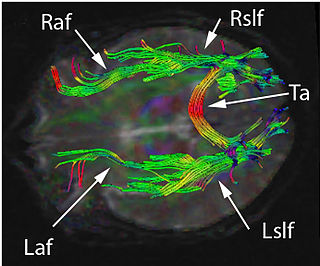Related Research Articles

Aphasia is an inability to comprehend or formulate language because of damage to specific brain regions. The major causes are a cerebral vascular accident (stroke) or head trauma. Aphasia can also be the result of brain tumors, brain infections, or neurodegenerative diseases, but the latter are far less prevalent.

Expressive aphasia, also known as Broca's aphasia, is a type of aphasia characterized by partial loss of the ability to produce language, although comprehension generally remains intact. A person with expressive aphasia will exhibit effortful speech. Speech generally includes important content words but leaves out function words that have more grammatical significance than physical meaning, such as prepositions and articles. This is known as "telegraphic speech". The person's intended message may still be understood, but their sentence will not be grammatically correct. In very severe forms of expressive aphasia, a person may only speak using single word utterances. Typically, comprehension is mildly to moderately impaired in expressive aphasia due to difficulty understanding complex grammar.
Hemiparesis, or unilateral paresis, is weakness of one entire side of the body. Hemiplegia is, in its most severe form, complete paralysis of half of the body. Hemiparesis and hemiplegia can be caused by different medical conditions, including congenital causes, trauma, tumors, or stroke.

Wernicke's aphasia, also known as receptive aphasia, sensory aphasia or posterior aphasia, is a type of aphasia in which individuals have difficulty understanding written and spoken language. Patients with Wernicke's aphasia demonstrate fluent speech, which is characterized by typical speech rate, intact syntactic abilities and effortless speech output. Writing often reflects speech in that it tends to lack content or meaning. In most cases, motor deficits do not occur in individuals with Wernicke's aphasia. Therefore, they may produce a large amount of speech without much meaning. Individuals with Wernicke's aphasia are typically unaware of their errors in speech and do not realize their speech may lack meaning. They typically remain unaware of even their most profound language deficits.

Neurotrauma, brain damage or brain injury (BI) is the destruction or degeneration of brain cells. Brain injuries occur due to a wide range of internal and external factors. In general, brain damage refers to significant, undiscriminating trauma-induced damage, while neurotoxicity typically refers to selective, chemically induced neuron damage.

Anomic aphasia is a mild, fluent type of aphasia where individuals have word retrieval failures and cannot express the words they want to say. Anomia is a deficit of expressive language. Anomia is a symptom of all forms of aphasia, but patients whose primary deficit is word retrieval are diagnosed with anomic aphasia. Some level of anomia is seen in all of the aphasias. Individuals with aphasia who display anomia can often describe an object in detail and maybe even use hand gestures to demonstrate how the object is used, but cannot find the appropriate word to name the object. Patients with anomic aphasia have relatively preserved speech fluency, repetition, comprehension, and grammatical speech.
Anosognosia is a condition in which a person with a disability is cognitively unaware of having it due to an underlying physical condition. Anosognosia results from physiological damage to brain structures, typically to the parietal lobe or a diffuse lesion on the fronto-temporal-parietal area in the right hemisphere, and is thus a neuropsychiatric disorder. A deficit of self-awareness, it was first named by the neurologist Joseph Babinski in 1914. Phenomenologically, anosognosia has similarities to denial, which is a psychological defense mechanism; attempts have been made at a unified explanation. Anosognosia is sometimes accompanied by asomatognosia, a form of neglect in which patients deny ownership of body parts such as their limbs. The term is from Ancient Greek ἀ- a-, 'without', νόσος nosos, 'disease' and γνῶσις gnōsis, 'knowledge'. It is also considered a disorder that makes the treatment of the patient more difficult, since it may affect negatively the therapeutic relationship.

Conduction aphasia, also called associative aphasia, is an uncommon form of difficulty in speaking (aphasia). It is caused by damage to the parietal lobe of the brain. An acquired language disorder, it is characterised by intact auditory comprehension, coherent speech production, but poor speech repetition. Affected people are fully capable of understanding what they are hearing, but fail to encode phonological information for production. This deficit is load-sensitive as the person shows significant difficulty repeating phrases, particularly as the phrases increase in length and complexity and as they stumble over words they are attempting to pronounce. People have frequent errors during spontaneous speech, such as substituting or transposing sounds. They are also aware of their errors and will show significant difficulty correcting them.

Joseph Chaikin was an American theatre director, actor, playwright, and pedagogue.
Transcortical sensory aphasia (TSA) is a kind of aphasia that involves damage to specific areas of the temporal lobe of the brain, resulting in symptoms such as poor auditory comprehension, relatively intact repetition, and fluent speech with semantic paraphasias present. TSA is a fluent aphasia similar to Wernicke's aphasia, with the exception of a strong ability to repeat words and phrases. The person may repeat questions rather than answer them ("echolalia").
Landau–Kleffner syndrome (LKS)—also called infantile acquired aphasia, acquired epileptic aphasia or aphasia with convulsive disorder—is a rare childhood neurological syndrome.

Primary progressive aphasia (PPA) is a type of neurological syndrome in which language capabilities slowly and progressively become impaired. As with other types of aphasia, the symptoms that accompany PPA depend on what parts of the left hemisphere are significantly damaged. However, unlike most other aphasias, PPA results from continuous deterioration in brain tissue, which leads to early symptoms being far less detrimental than later symptoms. Those with PPA slowly lose the ability to speak, write, read, and generally comprehend language. Eventually, almost every patient becomes mute and completely loses the ability to understand both written and spoken language. Although it was first described as solely impairment of language capabilities while other mental functions remain intact, it is now recognized that many, if not most of those afflicted suffer from impairment of memory, short term memory formation and loss of executive functions. It was first described as a distinct syndrome by M.‑Marsel Mesulam in 1982. Primary progressive aphasias have a clinical and pathological overlap with the frontotemporal lobar degeneration (FTLD) spectrum of disorders and Alzheimer's disease. However, PPA is not considered synonymous to Alzheimer's disease due to the fact that, unlike those affected by Alzheimer's disease, those with PPA are generally able to maintain the ability to care for themselves, remain employed, and pursue interests and hobbies. Moreover, in diseases such as Alzheimer's disease, Pick's disease, and Creutzfeldt-Jakob disease, progressive deterioration of comprehension and production of language is just one of the many possible types of mental deterioration, such as the progressive decline of memory, motor skills, reasoning, awareness, and visuospatial skills.

Be More Chill is a novel published on June 1, 2004 by American author Ned Vizzini. It is about a high school student named Jeremy Heere who takes the SQUIP, a pill that can make him more popular to his peers. The novel has been adapted to a popular stage musical, and is currently being adapted into a film and a graphic novel.
Dysprosody, which may manifest as pseudo-foreign accent syndrome, refers to a disorder in which one or more of the prosodic functions are either compromised or eliminated completely.
Jargon aphasia is a type of fluent aphasia in which an individual's speech is incomprehensible, but appears to make sense to the individual. Persons experiencing this condition will either replace a desired word with another that sounds or looks like the original one, or has some other connection to it, or they will replace it with random sounds. Accordingly, persons with jargon aphasia often use neologisms, and may perseverate if they try to replace the words they can not find with sounds.
Spontaneous recovery is a phenomenon of learning and memory that was first named and described by Ivan Pavlov in his studies of classical (Pavlovian) conditioning. In that context, it refers to the re-emergence of a previously extinguished conditioned response after a delay. Such a recovery of "lost" behaviors can be observed within a variety of domains, and the recovery of lost human memories is often of particular interest. For a mathematical model for spontaneous recovery see Further Reading.
"Sisters of the Sun" is the eighth episode of the American documentary television series Cosmos: A Spacetime Odyssey. It premiered on April 27, 2014, on Fox, and aired on April 28, 2014, on National Geographic Channel. The episode explores the violent cosmic phenomenon of supernovas, which on average occur once per galaxy per century or one billion times per year in the observable universe. The episode pays homage to the discoveries of two female astronomers, Cecilia Payne and Annie Jump Cannon, and the obstacles faced by women scientists, especially those working in the early 20th century. Payne discovered the chemical composition of stars and that they consist largely of hydrogen. Cannon developed the first catalog for the spectral characteristics of stars. The episode's title refers to the scientific contributions of the women scientists featured in the episode as well as how their discoveries helped advance our knowledge of the composition of stars.
Susan Yankowitz is an American dramatist and novelist who has created works on mortality, violence against women and the Jonestown Massacre.
"Love Hurts" is the twentieth episode of the first season of House, which premiered on the Fox network on May 10, 2005.

My Beautiful Broken Brain is a 2014 documentary film about the life of 34-year-old Lotje Sodderland after she suffered a hemorrhagic stroke as a result of a congenital vascular malformation in November 2011, initially experiencing aphasia, the complete loss of her ability to read, write, or speak coherently.
References
- 1 2 Samuel French, Inc. The House of Plays & Musical Plays for Over 175 Years
- ↑ "Susan Yankowitz's 'Night Sky' explores the cosmos and the human brain". NY Daily News. Retrieved 2012-07-14.
- ↑ "Talkin' Broadway – What's New on the Rialto? – Susan Yankowitz – 6/10/09". Talkinbroadway.com. 2009-06-20. Retrieved 2012-07-14.